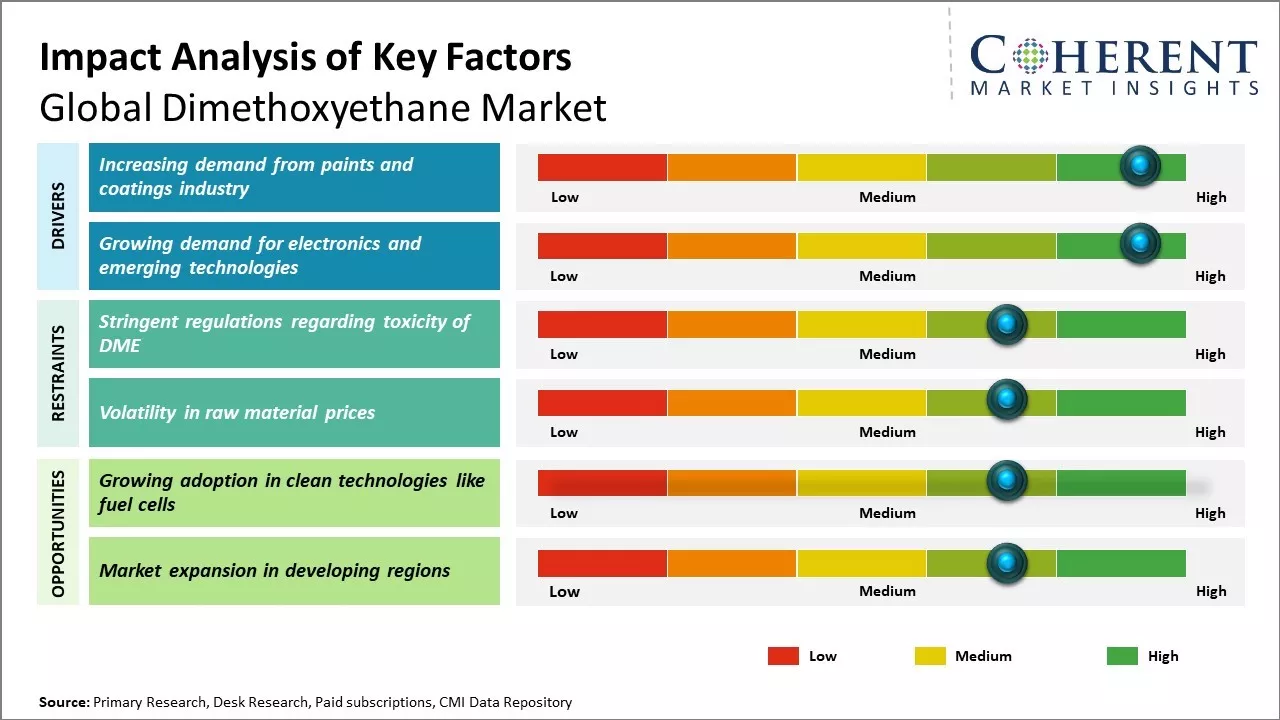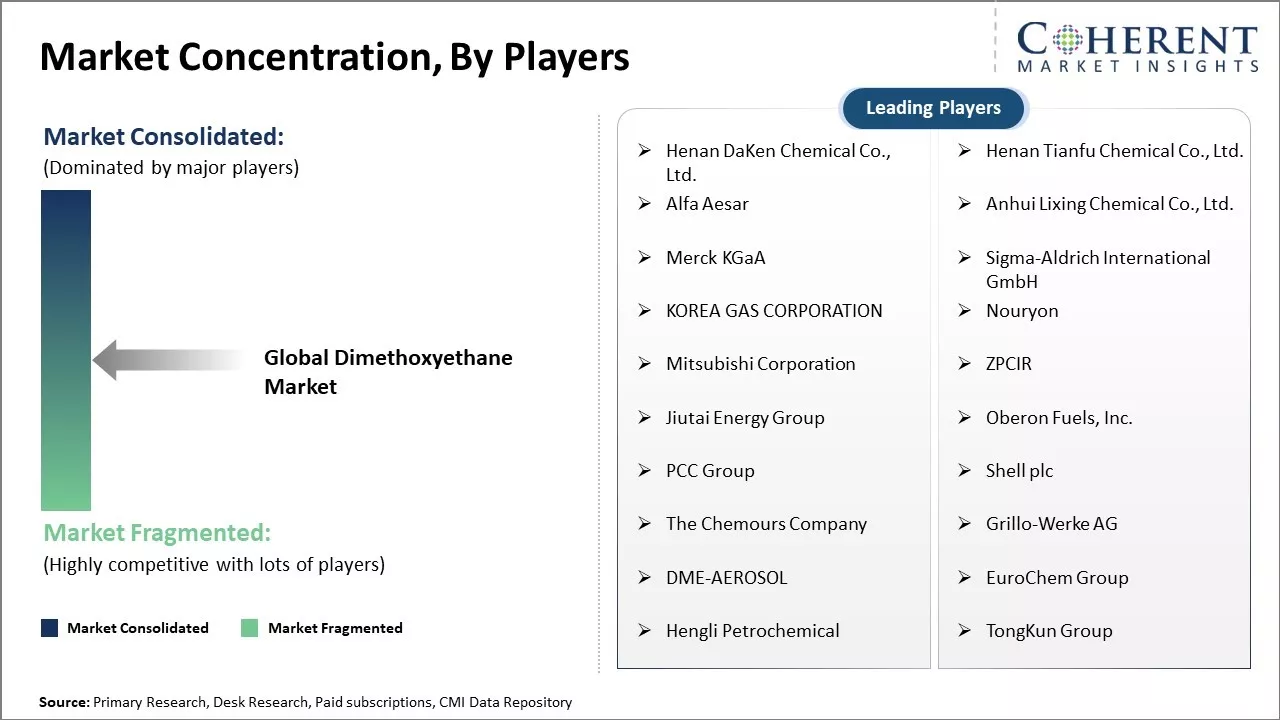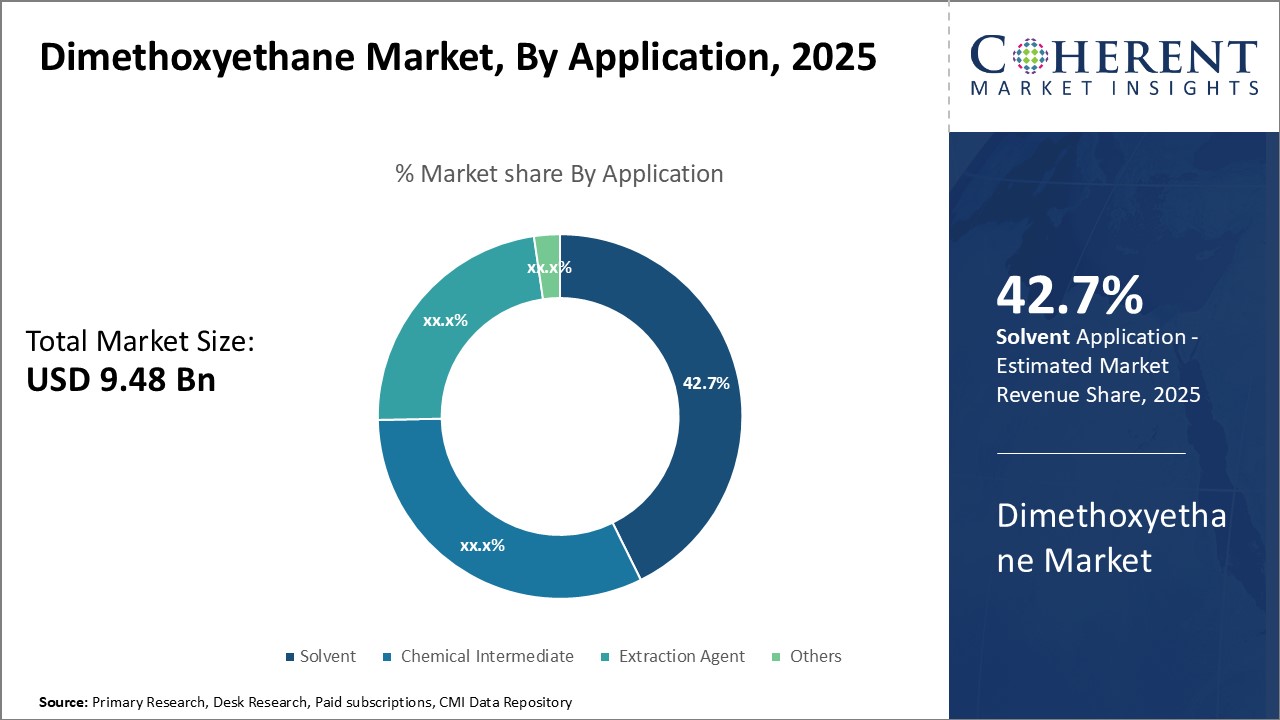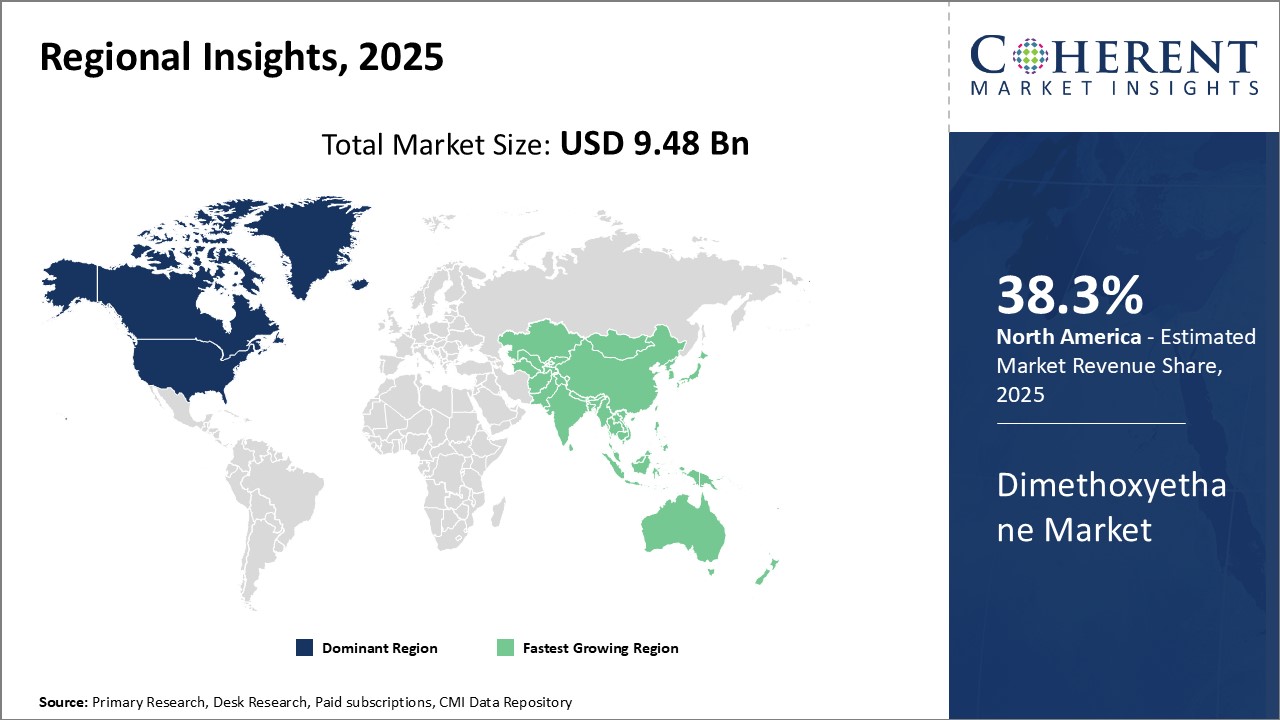Dimethoxyethane Market Size and Trends
The global dimethoxyethane market is estimated to be valued at USD 9.48 Bn in 2025 and is expected to reach USD 16.26 Bn by 2032, exhibiting a compound annual growth rate (CAGR) of 8.0% from 2025 to 2032.

Discover market dynamics shaping the industry: Download Free Sample
The global dimethoxyethane market is witnessing steady growth on account of increasing demand from various end-use industries such as paints and coatings, pharmaceuticals, and personal care products. The market is expected to witness positive growth over the forecast period supported by increasing consumption of dimethoxyethane in developing regions of Asia Pacific and Latin America. Additionally, rising demand from end-use industries like pharmaceuticals and agrochemicals owing to dimethoxyethane's solvent properties is further expected to drive the market growth during this period.
Market Driver - Increasing demand from paints and coatings industry
The paints and coatings industry has seen steady growth over the past few years driven by increasing construction activities across both residential and commercial sectors globally. For instance, according to data by Invest India released in 2022, the construction industry in India is expected to reach US$ 1.4 Tn by 2025. Dimethoxyethane or monoglyme is widely used as a solvent in paint formulations to effectively dissolve various organic resins, pigments, and binders. It has excellent solvent properties and provides superior transparency and gloss to paint films. Especially in architectural and industrial coatings which require durable, weather, and corrosion resistant paints, monoglyme plays a crucial role in improving the protective and performance characteristics of paints.
Its widespread use can be attributed to the rising infrastructure development projects in emerging economies of Asia Pacific and the Middle East regions. Mega construction of roads, bridges, buildings, factories, and other developmental works have accelerated the demand for high quality paints. Furthermore, redevelopment and renovation activities in developed nations of North America and Europe also contribute to the stable consumption of advanced paint systems. The growing affluence and consumer spending on home décor and furnishings has boosted the decorative paints market as well. This has positively influenced monoglyme uptake from paint manufacturers.
Stringent environmental regulations regarding Volatile Organic Compounds emissions from paints have led formulators to replace toxic solvents with eco-friendly alternatives like monoglyme. Its low volatility and non-carcinogenic nature make it a preferred thinning and cleaning agent compliant with various health, safety, and environmental standards. This regulatory push along with shifting customer preference for sustainable products is compelling paint companies to bank on green solvents and drive the monoglyme market. Moreover, continuous R&D investments by major players such as Sigma-Aldrich International GmbH and other players to enhance the performance attributes of paints using this solvent will maintain its importance in the industry in the coming years. Therefore, with the strong momentum expected in the construction and coatings sectors globally, the monoglyme demand is likely to track the growth trajectory of these end-use industries.
Market Concentration and Competitive Landscape

Get actionable strategies to beat competition: Download Free Sample
Growing demand from electronics and emerging technologies
The electronics industry has transformed dramatically in recent times owing rapid advancements in technology such as artificial intelligence, Internet of Things (IoT), 3D printing, renewable energy, and electric vehicles. Manufacturers are continuously introducing innovative smartphones, tablets, wearables, and semiconductor devices with more powerful performance at affordable prices. Monoglyme serves as an indispensable industrial solvent in the manufacturing processes of a wide range of electronic components like printed circuit boards, semiconductors, lithium-ion batteries, displays, and photovoltaic cells.
Its excellent dissolution properties enable effective cleaning of electronic substrates and efficient deposition of thin films through spin, dip, and spray coating techniques. Monoglyme's non-flammability and low toxicity are crucial safety attributes preferred during delicate electronic fabrication steps involving precision cleaning and material coating. Furthermore, increasing miniaturization of devices requires monoglyme-based formulations to deposit uniform, pinhole-free layers of metals, oxides and organic materials even on 3D microstructures. Rapid prototyping and waste reduction through the reuse of this solvent aids in boosting plant throughput and reducing production costs as well.
Emerging technologies oriented towards renewable energy sources like solar and wind power are projected to grow substantially over the coming decades. This will give a further impetus to the production of advanced photovoltaics, energy storage solutions, and electrical equipment worldwide. Automotive electrification through electric and hybrid electric vehicles is another lucrative segment driving battery manufacturing on a global scale, where monoglyme solvent plays a key role. Expanding 5G network infrastructure build-out and proliferation of IoT applications are also contributing meaningful opportunities. Therefore, strong growth is anticipated for monoglyme consumption across myriad electronics and energy technology verticals in the foreseeable future.
Key Takeaways from Analyst:
The growing demand from various end-use industries like paints, coatings, and adhesives will drive the global dimethoxyethane market growth during the forecast period. Dimethoxyethane is widely used as a solvent in these applications due to its favorable properties like low toxicity and vapor pressure. Rising demand from the coatings industry for environment-friendly solvents is likely to boost the market growth.
However, the market may face restraints from stringent regulations over volatile organic compound emissions. Regulatory authorities are promoting the use of green solvents to reduce VOC emissions from industries. This could negatively impact the demand for dimethoxyethane. Availability of alternative green solvents may also restrict the growth potential of this market.
The North America region, will continue dominating the global dimethoxyethane market during the projected timeframe. Rapid industrialization and growing end-use industries in the region offer large opportunities for market participants. Asia Pacific and Western Europe are also expected to offer promising growth opportunities due to the increasing demand for high-performance coatings from sectors such as automotive and aerospace in these regions.
Market Challenge - Stringent regulations regarding toxicity of DME
There are stringent regulations imposed on the usage of Dimethoxyethane (DME) globally due to its toxicity. DME is classified as a hazardous air pollutant in many countries India and other owing to its potential adverse effects on human health as well as the environment if leaked or improperly handled. The regions having strict emission standards like North America and Europe have imposed limits on the amount of DME that can be released into the atmosphere from production and usage facilities. This has compelled manufacturers to invest heavily in implementing advanced pollution control equipment and safety mechanisms during the entire lifecycle of DME, right from production to transportation and storage. Further, obtaining environmental permits for setting up new plants or expanding the existing capacities has become challenging over time. Such stringent quality and safety regulations have increased the overall production cost of DME. This acts as a major discouraging factor for various end-use industries employing DME to shift to alternative materials.
Market Opportunity - Growing adoption in clean technologies like fuel cells for market
There is a growing market opportunity for dimethoxyethane in clean technologies owing to its increasing adoption in fuel cell applications. DME is emerging as a promising fuel for polymer electrolyte membrane fuel cells (PEMFC) due to its physical and chemical properties like low toxicity, high cetane number, and ease of production from various sources including biomass. As fuel cells are increasingly being used across various mobility and stationary power segments as an alternative to conventional internal combustion engines, the demand for DME as a fuel is expected to rise tremendously over the coming years. Original Equipment Manufacturers (OEMs) are actively investing in developing DME-powered fuel cell vehicles and systems to cater to the green energy and emissions reduction needs. Governments across regions are also coming up with supportive policies and subsidies to promote the commercialization of fuel cell technologies.

Discover high revenue pocket segments and roadmap to it: Download Free Sample
Insights by application: Wide range of applications in end use industries
In terms of application, solvent is expected to contribute 42.7% share of the market in 2025. Dimethoxyethane or glyme is highly sought after as a solvent due to its excellent solvency power and high boiling point. It is able to dissolve a variety of organic and inorganic compounds effectively. Glyme finds extensive use as a solvent in chemical synthesis and extractions. Its polarity and stability make it a suitable medium for chemical reactions involving transition metals. Glyme is able to keep catalysts in solution and assists homogeneous catalysis. It also promotes high yields of products with few side reactions.
Glyme is commonly used as an activator and solvent for alkyl lithium compounds which are powerful yet moisture sensitive organic reagents. This enables smoother reactions with better control. Glyme-based solutions of organolithium compounds have gained popularity as they provide improved reactivity and selectivity over other hydrocarbon solvents. The widespread use of glyme as a reaction medium and for extraction of various metals and compounds from different sources has propelled the solvent segment to the forefront in the dimethoxyethane market.
Insights by end-use industry: Increasing R&D activities
In terms of end-use industry, pharmaceuticals is expected to contribute 39.4% share of the market in 2025. The pharmaceutical industry has emerged as the largest consumer of glyme owing to its extensive research activities, growing pharmaceutical industry is expected to drive the segment growth. For instance, according to data by Invest India released in 2022, the pharmaceutical industry in India is expected to reach US$ 65 Bn by 2024 and to US$ 130 Bn by 2030. Glyme fits the bill as an ideal green solvent for pharmaceutical synthesis due to its low toxicity. It meets stringent purity and safety standards set for medicinal chemistry. Glyme is able to deliver high yielding and clean reactions without the generation of toxic byproducts. This boosts its appeal among drug manufacturers.
Further, glyme enables the smooth progress of catalytic reactions involved in the production of active pharmaceutical ingredients (APIs). It is especially valued for facilitating palladium catalyzed cross-coupling reactions that construct C-C and C-N bonds in many drugs. With growing healthcare spending and continuous pipeline of new drugs, the demand for efficient synthetic pathways is rising. This is fueling the adoption of glyme-based processes and spurring growth in the pharmaceutical end-use segment. Glyme's bio-compatibility and ability to deliver critical intermediates in high yields make it a workhorse solvent for the innovative pharmaceutical industry.
Regional Insights

Need a Different Region or Segment? Download Free Sample
North America has established itself as the dominant region in the global dimethoxyethane market over the past decade. The region is expected to hold 38.3% of the market share in 2025. This is primarily due to strong demand from industries such as chemical processing and electronics manufacturing where dimethoxyethane is used as a reaction solvent and coating agent. The U.S., in particular, is home to several prominent players operating across the dimethoxyethane value chain, from raw material suppliers to product distributors. This level of industry presence helps ensure smooth supply chains and constant availability of the product.
Additionally, North American Free Trade Agreement (NAFTA) has enabled seamless import and export of dimethoxyethane between the U.S., Canada, and Mexico. Industrial facilities located near the borders take advantage of easy cross-border movement of cargo. Prevailing trade dynamics have led to competitive pricing within the region. Furthermore, research and development investments by manufacturers have led to continuous performance improvement and new applications for dimethoxyethane.
The dimethoxyethane market in Asia Pacific has emerged as the fastest growing regional market. In particular, China and India are expected to drive the bulk of future demand increases. These nations are witnessing rapid industrialization which has bolstered requirements for dimethoxyethane across sectors like coatings, cleaning agents, and others. Additionally, government initiatives aimed at industrial modernization are encouraging companies to set up new units or expand existing facilities. This translates to higher consumption of industrial chemicals and materials including dimethoxyethane. Sustained economic expansion will moreover bolster the spending ability of commercial enterprises as well as enable import of dimethoxyethane to meet rising needs.
Market Report Scope
Dimethoxyethane Market Report Coverage
| Report Coverage | Details | ||
|---|---|---|---|
| Base Year: | 2024 | Market Size in 2025: | USD 9.48 Bn |
| Historical Data for: | 2020 To 2024 | Forecast Period: | 2025 To 2032 |
| Forecast Period 2025 to 2032 CAGR: | 8.0% | 2032 Value Projection: | USD 16.26 Bn |
| Geographies covered: |
|
||
| Segments covered: |
|
||
| Companies covered: |
Henan DaKen Chemical Co., Ltd., Henan Tianfu Chemical Co., Ltd., Alfa Aesar, Anhui Lixing Chemical Co., Ltd., Merck KGaA, Sigma-Aldrich International GmbH, KOREA GAS CORPORATION, Nouryon, Mitsubishi Corporation, ZPCIR, Jiutai Energy Group, Oberon Fuels, Inc., PCC Group, Shell plc, The Chemours Company, Grillo-Werke AG, DME-AEROSOL, EuroChem Group, Hengli Petrochemical, and TongKun Group |
||
| Growth Drivers: |
|
||
| Restraints & Challenges: |
|
||
Uncover macros and micros vetted on 75+ parameters: Get instant access to report
Dimethoxyethane Industry News
- In May 2024, Lummus, a global provider of process technologies and infrastructure for the energy industry, launched its renewable dimethyl ether (rDME) technology. This innovative solution enables the production of rDME, a clean-burning fuel that can be used as a substitute for liquefied petroleum gas (LPG) or as a blending component in diesel fuel.
- In January 2022, Air Products, a chemical company, in collaboration with Indonesia-based coal miner, Bukit Asam, and energy company, Pertamina, commenced the construction of a new plant dedicated to converting coal into dimethyl ether (DME). This ambitious project involves an investment of USD 2.3 Bn.
- In 2021, Oberon Fuels began producing renewable dimethyl ether (rDME) on a commercial scale. At its upgraded facility in Brawley, California, the company is transforming waste methanol into rDME as part of a US$6 million project, which received partial funding from a grant awarded by the California Energy Commission. This marks the first instance of using feedstock to produce rDME on a large scale.
- In 2021, a joint venture was established between Mitsubishi Heavy Industries Engineering (MHIENG), Mitsubishi Gas Chemical Company (MGC), Mitsubishi Corporation (MC), and the National Gas Company of Massy Holdings (Massy) in Trinidad and Tobago, Caribbean. The joint venture, named Caribbean Gas Chemical Limited (CGCL), launched commercial operations of a dimethyl ether (DME) and methanol plant in the Republic of Trinidad and Tobago, located in the Caribbean region.
*Definition: The global dimethoxyethane market is a B2B marketplace for buyers and sellers of dimethoxyethane. Also known as glyme or dimethyl ether, dimethoxyethane is an organic compound with many industrial uses as a solvent. It is a colorless, volatile, and water-immiscible liquid. The global dimethoxyethane market enables customers across multiple industry verticals like chemicals, electronics, pharmaceuticals, and plastics to source high-quality dimethoxyethane from vetted suppliers on a global scale.
Market Segmentation
- Application Insights (Revenue, USD Bn, 2020 - 2032)
- Solvent
- Chemical Intermediate
- Extraction Agent
- Others
- End-use Industry Insights (Revenue, USD Bn, 2020 - 2032)
- Pharmaceuticals
- Agriculture
- Chemical Manufacturing
- Cosmetics
- Others
- Regional Insights (Revenue, USD Bn, 2020 - 2032)
- North America
- U.S.
- Canada
- Latin America
- Brazil
- Argentina
- Mexico
- Rest of Latin America
- Europe
- Germany
- U.K.
- Spain
- France
- Italy
- Russia
- Rest of Europe
- Asia Pacific
- China
- India
- Japan
- Australia
- South Korea
- ASEAN
- Rest of Asia Pacific
- Middle East
- GCC Countries
- Israel
- Rest of Middle East
- Africa
- South Africa
- North Africa
- Central Africa
- North America
- Key Players Insights
- Henan DaKen Chemical Co., Ltd.
- Henan Tianfu Chemical Co., Ltd.
- Alfa Aesar
- Anhui Lixing Chemical Co., Ltd.
- Merck KGaA
- Sigma-Aldrich International GmbH
- KOREA GAS CORPORATION
- Nouryon
- Mitsubishi Corporation
- ZPCIR
- Jiutai Energy Group
- Oberon Fuels, Inc.
- PCC Group
- Shell plc
- The Chemours Company
- Grillo-Werke AG
- DME-AEROSOL
- EuroChem Group
- Hengli Petrochemical
- TongKun Group
Share
Share
About Author
Vidyesh Swar is a seasoned Consultant with a diverse background in market research and business consulting. With over 6 years of experience, Vidyesh has established a strong reputation for his proficiency in market estimations, supplier landscape analysis, and market share assessments for tailored research solution. Using his deep industry knowledge and analytical skills, he provides valuable insights and strategic recommendations, enabling clients to make informed decisions and navigate complex business landscapes.
Missing comfort of reading report in your local language? Find your preferred language :
Transform your Strategy with Exclusive Trending Reports :
Frequently Asked Questions
EXISTING CLIENTELE
Joining thousands of companies around the world committed to making the Excellent Business Solutions.
View All Our Clients
